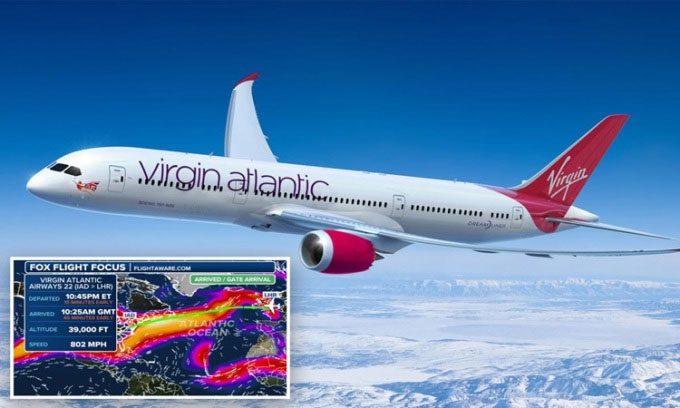Commercial aircraft can reach maximum speeds of 1,200 – 1,300 km/h when aided by strong winds.
Winds reaching 426 km/h swept through Washington at an altitude of approximately 10,668 meters above ground level (the cruising altitude of aircraft) as a powerful jet stream moved through the area on the evening of February 17. As a result, at least three commercial flights reached speeds exceeding 1,287 km/h, according to the Washington Post. The National Weather Service in the Washington-Baltimore area reported that the wind speed of 426 km/h is the second highest recorded since the 1950s, with the highest recorded wind speed at that altitude being 430 km/h on December 6, 2002.

A Virgin Atlantic flight arrives early thanks to strong winds. (Photo: AOL).
Flight number 22 of Virgin Atlantic, departing from Washington Dulles International Airport to London, took off at 10:45 PM local time on February 17 and landed 45 minutes ahead of schedule. Boosted by extremely strong tailwinds, the Virgin Atlantic jet reached a maximum speed of 1,290 km/h at 11:20 PM on February 17, according to data from online tracking site Flight Aware. The aircraft achieved this speed while flying over the Atlantic Ocean east of Long Island during its ascent into the jet stream. After exiting the jet stream to the north, the aircraft maintained a speed of 965 – 1,126 km/h, slightly faster than the typical cruising speed.
While the maximum speed of the flight exceeded the speed of sound (1,234 km/h), the aircraft did not break the sound barrier. Although the speed on the runway (the combined speed of the aircraft and the push from the wind) exceeded the speed of sound, the aircraft still traveled through the surrounding air at a normal cruising speed.
Flight 64 of United Airlines from Newark to Lisbon, departing at 8:35 PM local time on February 17, achieved a runway speed of 1,343 km/h, according to Flight Aware. The flight to Lisbon arrived 20 minutes early. Similarly, Flight 120 of American Airlines from Philadelphia to Doha, Qatar, reached speeds of 1,352 km/h, among the highest in history.
These high-speed flights occurred less than a month after a China Airlines aircraft reached a speed of 1,329 km/h over the Pacific Ocean, also propelled by tailwinds blowing at 402 km/h.
The strong winds on the evening of February 17 in the Central Atlantic region were detected by weather balloons launched from the office of the National Weather Service in Sterling, Virginia. The office releases weather balloons every 12 hours, and the data from these balloons is incorporated into computer models that assist with forecasts. Winds continued to blow strongly in Washington the following morning. Tom Niziol, a weather expert, reported that at 7 AM on February 18, the weather balloon from Sterling recorded wind speeds of 396 km/h at an altitude of 11,582 meters.
Strong winds developed due to the contrast between the extremely cold air flowing through the Northeast and the mild air in the Southeast. At 7 PM on February 17, temperatures dropped below 0°C in Maine while exceeding 20°C in South Florida.


















































